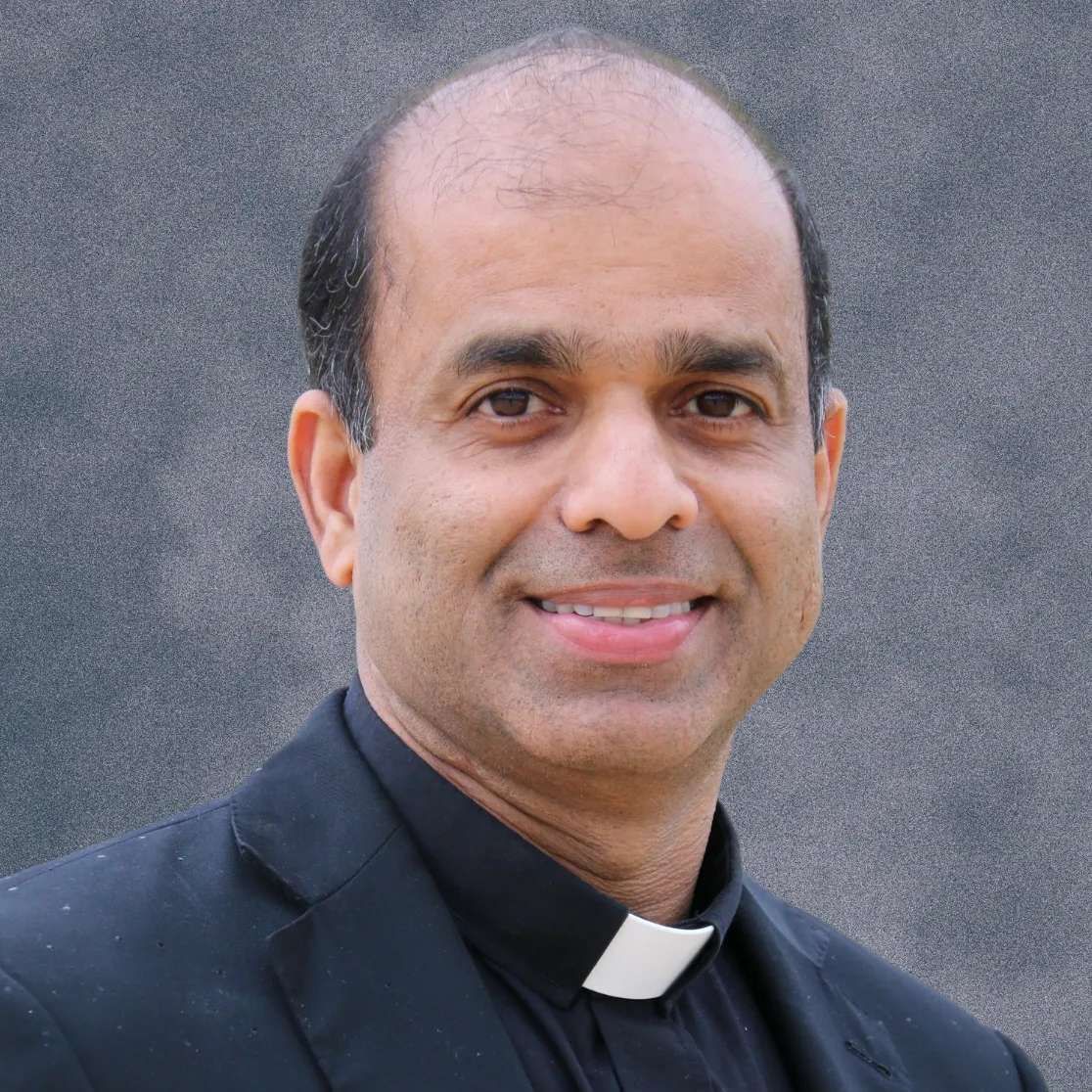
Teaching Mass – Part 1 of 4 | June 29, 2025
My Dear Parishioners,
The need for a “Teaching Mass” was strongly expressed by Mary Queen parishioners during our Listening Sessions when I first arrived here. For the next few weekends, you will find articles in the “Pastor’s Message” column based on the book “Eucharist – Celebrating Its Rhythms in Our Lives” by Father Paul Bernier. He writes:
“It is helpful to think of the liturgy as a dance God invites us to join. We are affected by what we do. To speak of the liturgy as a dance is to realize that it is God who pipes the tune, who sets the basic rhythms. For each of us the dance will be different, reflecting the differences in our bodies, our lives, our relationships. Only in the liturgy do all of life’s rhythms come together.”
Father Bernier goes on to describe five different rhythms found in Eucharistic celebrations. Let us reflect on the first of four such rhythms this week.
1. The Gathering Rhythm: This is seen in the “dance” in which each family and each person works to show up for Mass. When we gather, we gather as a united family. We gather around the altar as sons and daughters of God. We gather as one family, having one creed, one faith, one baptism. This is a holy time in which our differences melt away, and we become one body worshipping our Creator. Coming together - assembling - is at the heart of our Sunday worship. The purpose of these rites is to bring us together into one body, ready to listen and to break bread together.
Greeting: In many churches today, there will be someone at the door to greet you as you arrive for Sunday Mass. We all like to be greeted and welcomed when we gather for a celebration. When friends come for a meal or a party, we greet them at the door and welcome them into our home.
Use of Holy Water: One of the first things Catholics do when they come to church is to dip their right hand in holy water and make the sign of the cross. This ritual is a reminder of our Baptism: we were baptized with water and signed with the cross. At every Mass, we renew our promises to die to sin.
Genuflection: In medieval Europe, it was customary to go down on one knee to genuflect before a king or person of rank. This secular mark of honor gradually entered the Church, and people began to genuflect to honor the altar and the presence of Christ in the tabernacle before entering the pew. Today, many people express their reverence with an even older custom and bow to the altar before taking their place.
Posture and Song: When the Mass begins, everyone stands. Standing is the traditional posture of the Christian at prayer: it expresses our attentiveness to the word of God and our readiness to carry it out. Often, we begin by singing together. What better way to gather than to unite our thoughts and our voices in common words, rhythm, and melody?
Greeting (at the Altar): The priest will ask us to begin with the sign of the cross—again reminding us of Baptism—and will greet us, saying, “The Lord be with you.” It is both a wish and a profound statement of faith. It is an ancient biblical greeting: Boaz returned from Bethlehem (Ruth 2:4) and said to the reapers, “The Lord be with you!” The ritual response to this greeting is always the formula, “And with your spirit,” by which we return the hello, the good wishes, the statement of faith.
Penitential Rite and Gloria: All the other ritual acts of this first part of the Mass are intended to gather us together into a worshiping assembly. Sometimes we are asked to pause and recall our common need for salvation. Sometimes the hymn “Glory to God in the Highest” is sung or recited at this point. The Gloria has been a part of the Mass since about the sixth century!
Opening Prayer: At the close of this first part of the Mass, the priest will ask us to join our minds in prayer. After a few moments of silence, he will collect our intentions into one prayer, to which we all respond “Amen”—a Hebrew word meaning “So be it.”
✝ ✝ ✝
Teaching Mass – Part 2 of 4 | July 6, 2025
I had the opportunity to meet Fr. Paul Bernier, a Blessed Sacrament priest, when he visited the La Salette Shrine in Silang, Cavite in the Philippines several years ago. His book on the Eucharist was quite inspiring while I was studying Theology, so allow me to continue reflecting on the significance of the Mass.
2. The Storytelling Rhythm – Human beings love a good story. Storytelling is not merely about those who lived during the Old Testament or in the time of Jesus and His teaching, but also about how our stories echo theirs. We can discover that we are not unique in our struggle to understand the will of God for our lives. We can learn that God’s mercy and love are infinite, even though understanding this takes a lifetime. These stories are important because they teach us that we are not alone, and that our lives matter to our Creator.
Liturgy of the Word – When we gather at a friend’s home for a meal, we always begin with conversation, telling our stories. At Mass, after the rites of gathering, we sit down and listen as readings from the Word of God are proclaimed. These are the stories of God’s people. On Sundays, there are three readings and a psalm. The first reading will be from the Hebrew Scriptures, except during the Easter season. We have not generally been famous for our Bible reading, and yet the Mass has always been fundamentally biblical. Even some Catholics might be surprised to learn how much of the Mass is taken from the Bible: not only the three readings and the psalm, and the obviously biblical prayers such as the “Holy, Holy, Holy” and the Lord’s Prayer, but most of the words and phrases of the prayers of the Mass are drawn from Scripture.
Standing for the Gospel – Because of the unique presence of Christ in the proclamation of the Gospel, it has long been the custom to stand in attentive reverence to hear these words. We believe that Christ is present in His word, since it is He Himself who speaks when the holy Scriptures are read in the Church. The priest will again greet us with “The Lord be with you.” He then introduces the Gospel reading while marking a small cross on his forehead, lips, and heart with his thumb, silently praying that God cleanses his mind and heart so that his lips may worthily proclaim the Gospel. In many places, the congregation performs this ritual action along with the priest.
Homily
– This means more than just a sermon or a talk about how we are to live or what we are to believe. It is an act of worship rooted in the texts of the Mass and especially in the readings from Scripture that have just been proclaimed. The homily takes that word and brings it to our life situation today. Just as a large piece of bread is broken to feed individual persons, the Word of God must be broken open so it can be received and digested by the congregation.
Creed – Now we stand and together recite the Creed. The Creed is more than a list of things we believe. It is a statement of our faith in the Word we have heard proclaimed in the Scripture and the homily, and a profession of the faith that leads us to give our lives for one another, as Christ gave His life for us.
Universal Prayer – The intercessions help us become who God is calling us to be. We are the Body of Christ by Baptism. We pray that our assembly truly comes to resemble the Body of Christ—a body at peace, with shelter for the homeless, healing for the sick, and food for the hungry. We pray for the Church, for nations and their leaders, for people in special need, and for the local needs of our parish—and the petitions usually fall into these four categories.
✝ ✝ ✝
Teaching Mass – Part 3 of 4 | July 13, 2025
In the last two weeks’ bulletins, I shared with you two different rhythms in the celebration of the Mass—the
Gathering Rhythm and the
Storytelling Rhythm. This week, let us reflect on the third rhythm, which Fr. Paul Bernier calls the “Nurturing Rhythm.” This is the part of the Eucharist that corresponds to the Communion Rite. During this time, we are fed no ordinary food, but rather the
Body and Blood, Soul and Divinity of Jesus Christ! If we are open to the grace, it slowly changes us to become more and more like Christ Himself. We are nurtured to become one with the Trinity! This cultivates our local Church to become supportive and welcoming in every aspect of ministry.
After the readings, we move to the table of the Eucharist. As at a meal in the home of a friend, we (1) set the table, (2) say grace, and (3) share the food. We eat and drink. At Mass, these ritual actions are called:
1. the Preparation of the Gifts
2. the Eucharistic Prayer
3. the Communion Rite
Preparation of the Gifts:
The early Christians each brought some bread and wine from their homes to the church to be used for the Mass and to be given to the clergy and the poor. Today, a similar offering for the parish and the poor is made through our monetary contributions. Members of the parish take up a collection from the assembly and bring them to the priest at the altar along with the bread and wine to be used for the sacrifice.
The Eucharistic Prayer which follows brings us to the very center of the Mass and the heart of our faith. The prayer begins with a dialogue between the presider and the assembly. First, the priest greets us with: “The Lord be with you.” He then asks if we are ready and willing to approach the table and to renew our baptismal commitment, offering ourselves to God: “Lift up your hearts.” We respond that we are prepared: “We lift them up to the Lord.” We are invited to give thanks to the Lord our God, and we respond: “It is right and just.” To “give thanks” translates the traditional Greek verb which now names the whole action:
Eucharist.
Preface and Acclamation:
The priest enters the Preface, a prayer which prepares us to come before the face of God. As the wonders of God are told, the assembly cannot hold back their joy and sing aloud: “Wow! Wow! Wow! What a God we have!” In the ritual language of the Mass, this acclamation takes the form: “Holy, holy, holy Lord, God of hosts. Heaven and earth are full of your glory.”
The priest continues the prayer, giving praise and thanks and calling upon the Holy Spirit to change our gifts of bread and wine into the Body and Blood of Christ. He then recalls the events of the Last Supper—the institution of the Eucharist—and continues recalling the wonderful deeds of salvation: the Passion, Death, and Resurrection of Christ.
We look forward to that glorious day and raise our voices with those of all the saints who have gone before us as the priest raises the consecrated bread and wine and offers a toast—a doxology, a prayer of glory to God in the name of Christ: “Through Him, and with Him, and in Him, O God, almighty Father, in the unity of the Holy Spirit, all glory and honor is Yours, for ever and ever.” Our “Amen” to this prayer proclaims our assent and participation in the entire Eucharistic Prayer.
✝ ✝ ✝
Teaching Mass – Part 4 of 4 | July 20, 2025
This is the fourth and final write-up on the “Teaching Mass.” Allow me to continue with the Nurturing Rhythm from last week by sharing some thoughts on the Communion Rite, the Our Father, and the Sign of Peace.
We prepare to eat and drink at the Lord’s table with those words taught to us by Jesus: “Give us this day our daily bread; and forgive us our trespasses as we forgive those who trespass against us.” Keenly aware that communion is both the sign and source of our reconciliation and union with God and one another, we make a gesture of union and forgiveness with those around us by offering them a sign of peace. The priest then shows us the Body of Christ and invites us to come to the table: “Behold the Lamb of God... Blessed are those called to the supper of the Lamb.”
The members of the assembly now approach the altar in procession. As God fed our ancestors in the desert on their pilgrimage, so God gives us food for our journey. We approach the priest or minister who gives us the Eucharistic bread with the words, “The Body of Christ,” and we respond, “Amen.” We then go to the deacon or minister with the cup, who gives it to us with the words, “The Blood of Christ,” to which we again profess our “Amen.”
During this procession, we usually sing a hymn, which unites our voices, minds, and hearts, even as the Body and Blood of Christ unite our bodies. We then pray silently in our hearts, thanking and praising God, and asking for all that this sacrament promises. The priest unites our prayers in the Prayer After Communion, to which we respond, “Amen.”
4. PROPHETIC AND MISSIONING RHYTHM
We are commissioned to go forth and dance God’s dance for the world to see. By dancing this dance, we evangelize others about God’s glory, grace, and blessing in our lives. Finally, we prepare to go back into the world in which we will live for the coming week. The burdens we laid down at the door of the church for this Eucharist we now must bear again, but we do so strengthened by this Eucharist and by this community.
After the final blessing, the priest or deacon dismisses the assembly: “Go in peace.” And we give our liturgical “yes” by saying, “Thanks be to God.” We leave the assembly and the church building, but we carry something with us.
What happens in our lives during the week gives deeper meaning to the ritual actions we celebrated at Mass, whether it’s family life or serving the poor. It is only in relation to our daily lives that the full meaning of the Mass becomes clear to us.
This is God’s dance - the dance of the Kingdom. Building this Kingdom makes us dance according to His rhythm, His rules. We are called not to allow the world to change us, but, guided by His Spirit, to change the world.
Shall we dance?
Many Blessings,
Fr. Thomas Vellappallil, MS



